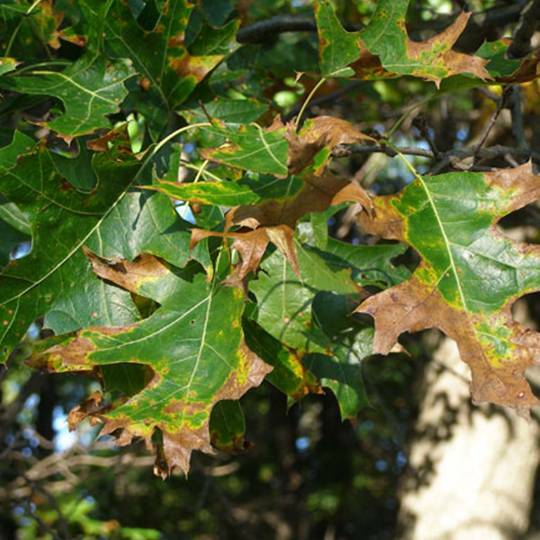Oaks are our legacy here at the Landis Arboretum, what with the land originally known as “Oak Nose Farm” after the 500-year-old “Great Oak” that once stood overlooking the Schoharie Valley. Oaks are a big part of our functioning ecosystem, which includes plants, fungi, and wildlife. When the approach of oak wilt was reported, we stood by hoping it would not reach the Arboretum, and so far, so good. That being said, oak wilt has been identified in neighboring Schenectady County.

Oak wilt is a systemic, lethal disease caused by the fungus Bretziella fagacearu (previously known as Ceratocystis fagacearum). The fungus is spread via root grafts and beetles feeding on sap at open wounds or on the leaves of healthy trees. Once inside the tree, the fungus begins to replicate, eventually preventing the uptake and movement of water. Symptoms of the disease first appear near the top of the canopy. The outside of the leaves turn bronze, brown, or dull green, usually starting at the top of the leaf, while the base of the leaf remains green. Some leaves curl and begin to drop soon after symptoms appear.
It is more likely to affect red oak than white oak. An infected red oak typically dies within two months, while a white oak can live with the disease for several years. If infected, a tree will begin to show symptoms in mid-summer.
In the past, preventative measures included trenching between tree roots, pruning only during hard winter, and removing diseased trees. Today, focusing on reducing monoculture plantings, restoring soils, and applying fungicides in urban environments are proven to be more effective. It is important to note that there are ways to “control” the disease rather than just “contain” it. Containing it means to create a barrier and hope it doesn’t spread. Controlling the disease takes more effort and involves going within the barrier to remove the oaks, allowing native species to regrow. In essence, you woule remove all oaks, especially in a monoculture setting.
Oak wilt could impact Landis.
At Landis, we have several species of trees and plants mixed in with our oak forests, which would prove helpful in mitigating the spread of the disease should it occur. While our historic oak collection is at risk as the roots make contact, they are also mature and strong, which might help them survive. Sadly, if oak wilt were to occur at Landis, in essence, we would remove all oaks from our property in order to prevent the spread of the disease to other locations.
There is hope, however. Oak wilt was recently found in South Bristol, NY (Ontario County). After removal of infected trees and root trenching efforts to prevent spreading, the disease site is now receiving a clean bill of health. Working together, the Department of Environmental Conservation and the landowner were able to eradicate the disease and prevent neighboring forests from being destroyed as well.
We will continue to monitor the situation, continually checking the health of our oaks. While we hope no action will be necessary, we also are committed to preserving the greater forest environment, both inside and outside the Arboretum boundaries.
